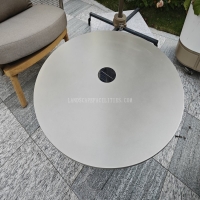Welcome to the website for landscape facilities products and knowledge.
How does the design of a landscape bar counter influence its ability to accommodate both self-serve and full-service models?
The integration of self-serve and full-service models within hospitality environments demands innovative design solutions, and the landscape bar counter emerges as a pivotal architectural element in achieving this synergy. Unlike traditional linear counters, landscape bars—characterized by their expansive, multi-dimensional forms—create distinct yet interconnected zones that simultaneously support autonomous customer interaction and traditional bartender services. This design approach fundamentally transforms operational dynamics while enhancing spatial functionality.
A primary advantage lies in the counter's strategic zoning capability. By incorporating designated self-serve stations equipped with integrated tap systems, digital ordering interfaces, or refrigerated display units, patrons can independently access beverages without disrupting full-service operations. These areas typically feature lower counter heights for accessibility and are often positioned at the bar's peripheries to encourage flow. Conversely, the full-service zone maintains conventional bar height, providing dedicated space for bartenders to craft complex cocktails, process payments, and engage directly with customers. This physical delineation minimizes congestion and allows both models to operate concurrently without compromising efficiency.
Material selection and layout further influence functionality. Durable, non-porous surfaces like quartz or polished concrete withstand high traffic in self-serve areas while facilitating easy cleaning. The counter's shape—whether curved, angular, or segmented—can naturally guide movement, separating quick-service transitions from leisurely seated experiences. For instance, a curved landscape bar might orient self-serve taps along one arc while directing seated guests toward the service-intensive side, thus intuitively managing customer behavior.
Technology integration is another critical facet. Wireless payment systems at self-serve points reduce wait times, while embedded sensors can monitor inventory levels in real-time, alerting staff to restock needs. Meanwhile, the full-service section benefits from traditional tools like ice wells, sinks, and storage, ensuring bartenders have uninterrupted workspaces. This technological harmony allows venues to scale services based on demand—shifting focus during peak hours without structural changes.
Ultimately, the landscape bar counter’s success hinges on its ability to balance autonomy with hospitality. By architecturally acknowledging both service styles, it not only optimizes operational flexibility but also elevates the user experience, catering to diverse preferences within a unified design framework.
Related search:

Recommendation
Outdoor stainless steel table with solar-powered ambient lighting feature - excellent design.